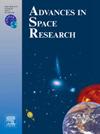Investigating the spatiotemporal variations of GNSS precipitable water and characteristics during drought period based on the empirical Tm model in Yunnan, China
IF 2.8
3区 地球科学
Q2 ASTRONOMY & ASTROPHYSICS
引用次数: 0
Abstract
Precipitable water vapor (PWV) as an important parameter of atmospheric water vapor can be obtained through global navigation satellite system (GNSS), which offers high-precision observations in all-weather conditions. It is difficult for the current meteorological observing systems to measure PWV under extreme weather conditions. GNSS-derived PWV has high temporal and spatial resolutions, being a reliable and stable data source for meteorology. In this study, we establish an empirical model for the atmospheric weighted mean temperature () in Yunnan, China based on radiosonde data collected from 2020 to 2022. The model is verified by assessing its accuracy using measurements of four radiosondes in 2023. The results show that the empirical model is more accurate compared to other widely used models such as GPT2w model, Li model, and Bevis model. The root mean square (RMS) of obtained from the empirical models are 3.5 K, 2.3 K, 2.1 K and 2.1 K with average bias of −0.10 K, 0.22 K, 0.04 K, and 0.32 K, respectively. We use GNSS to obtain PWV and validate the GNSS-derived PWV using data from the radiosonde station in Kunming, Yunnan. The GNSS PWV is consistent with the PWV measured by the radiosondes. The RMS of the GNSS-PWV of the years 2020, 2021, and 2022 are 3 mm, 2.2 mm, and 2.9 mm, respectively, and the GNSS-PWV is confirmed to have a higher accuracy compared to others. Additionally, this study analyzes the spatiotemporal variations of GNSS PWV over Yunnan in 2021. The result shows that GNSS-derived PWV varies with geographic location and season and is significantly related to precipitation. Through the analysis of PWV during drought periods in 2021 and comparison with the same period in 2020 and 2022, we find that PWV is significantly lower in 2021 than in the same period of other years. Understanding the spatiotemporal distribution of PWV is crucial for meteorological monitoring and weather forecasting.
基于经验Tm模型的云南干旱期GNSS可降水量时空变化特征研究
可降水量(PWV)作为大气水汽的重要参数,可通过全球卫星导航系统(GNSS)获得,提供全天候高精度观测。目前的气象观测系统难以测量极端天气条件下的PWV。gnss衍生的PWV具有较高的时空分辨率,是可靠、稳定的气象数据源。基于云南2020 - 2022年的大气加权平均温度(Tm)数据,建立了该地区大气加权平均温度(Tm)的经验模型。通过2023年使用四个无线电探空仪测量评估其准确性来验证该模型。结果表明,与GPT2w模型、Li模型、Bevis模型等广泛使用的模型相比,经验Tm模型具有更高的精度。从经验模型得到的Tm均方根(RMS)分别为3.5 K、2.3 K、2.1 K和2.1 K,平均偏差分别为- 0.10 K、0.22 K、0.04 K和0.32 K。利用GNSS获取PWV,并利用云南昆明探空站的数据验证GNSS导出的PWV。GNSS PWV与无线电探空仪测得的PWV一致。2020年、2021年和2022年的GNSS-PWV的均方根分别为3 mm、2.2 mm和2.9 mm,证实了GNSS-PWV的精度高于其他GNSS-PWV。此外,分析了2021年云南GNSS PWV的时空变化特征。结果表明,gnss获取的PWV随地理位置和季节的变化而变化,且与降水显著相关。通过对2021年干旱期PWV的分析,并与2020年和2022年同期进行对比,我们发现2021年PWV明显低于其他年份同期。了解PWV的时空分布对气象监测和天气预报具有重要意义。
本文章由计算机程序翻译,如有差异,请以英文原文为准。
求助全文
约1分钟内获得全文
求助全文
来源期刊

Advances in Space Research
地学天文-地球科学综合
CiteScore
5.20
自引率
11.50%
发文量
800
审稿时长
5.8 months
期刊介绍:
The COSPAR publication Advances in Space Research (ASR) is an open journal covering all areas of space research including: space studies of the Earth''s surface, meteorology, climate, the Earth-Moon system, planets and small bodies of the solar system, upper atmospheres, ionospheres and magnetospheres of the Earth and planets including reference atmospheres, space plasmas in the solar system, astrophysics from space, materials sciences in space, fundamental physics in space, space debris, space weather, Earth observations of space phenomena, etc.
NB: Please note that manuscripts related to life sciences as related to space are no more accepted for submission to Advances in Space Research. Such manuscripts should now be submitted to the new COSPAR Journal Life Sciences in Space Research (LSSR).
All submissions are reviewed by two scientists in the field. COSPAR is an interdisciplinary scientific organization concerned with the progress of space research on an international scale. Operating under the rules of ICSU, COSPAR ignores political considerations and considers all questions solely from the scientific viewpoint.
 求助内容:
求助内容: 应助结果提醒方式:
应助结果提醒方式:


